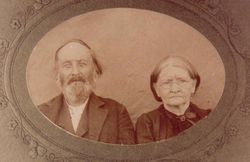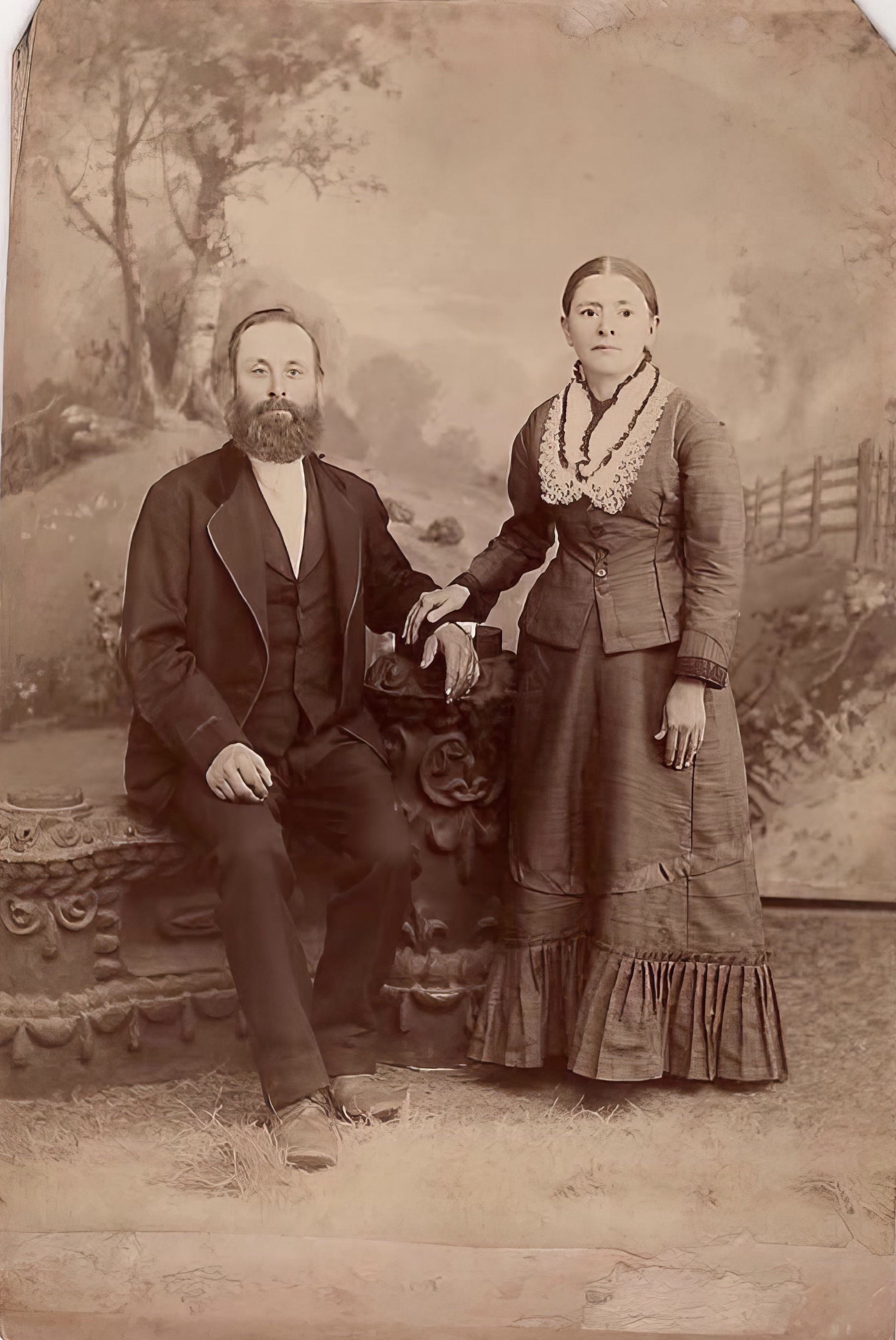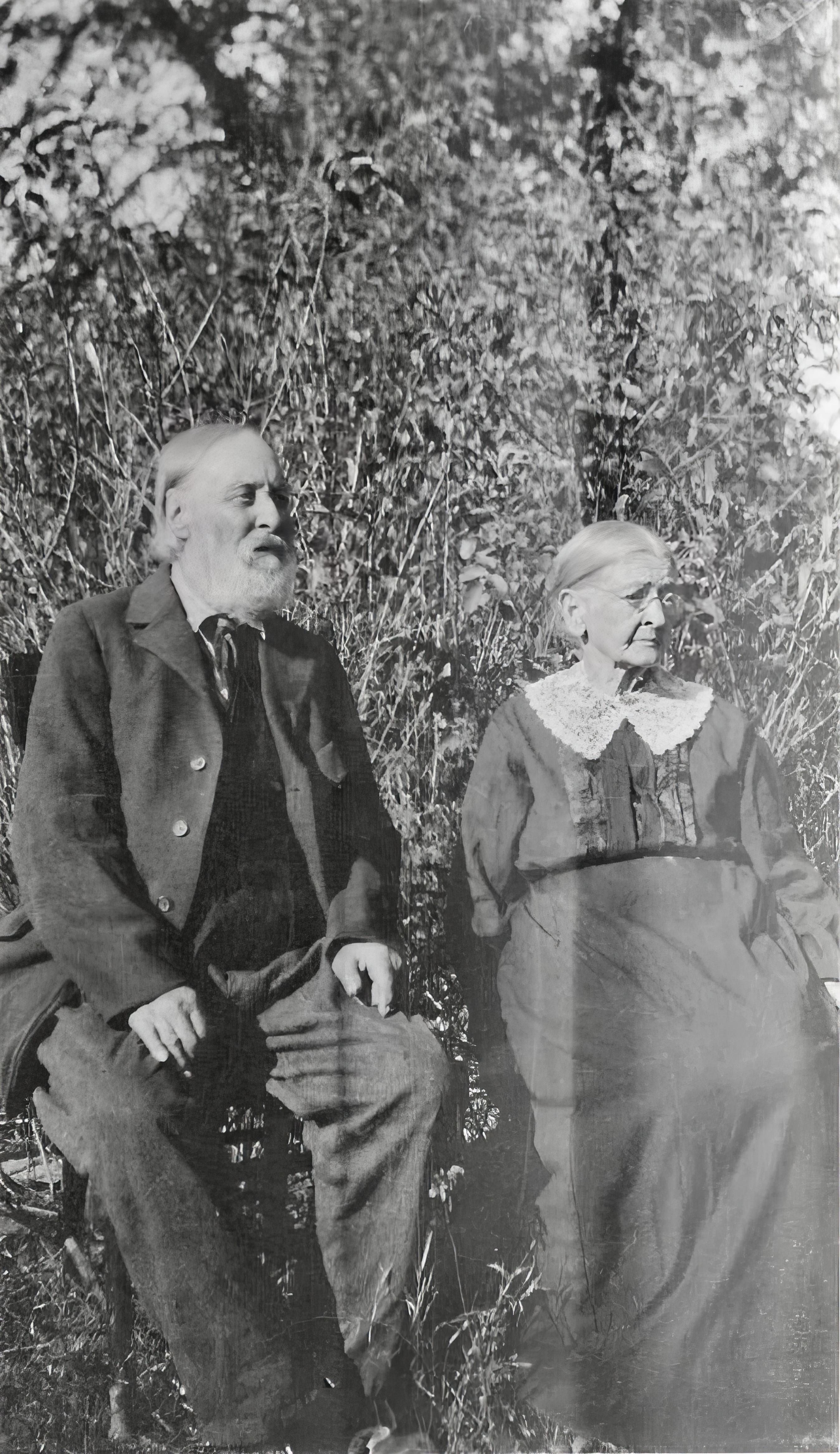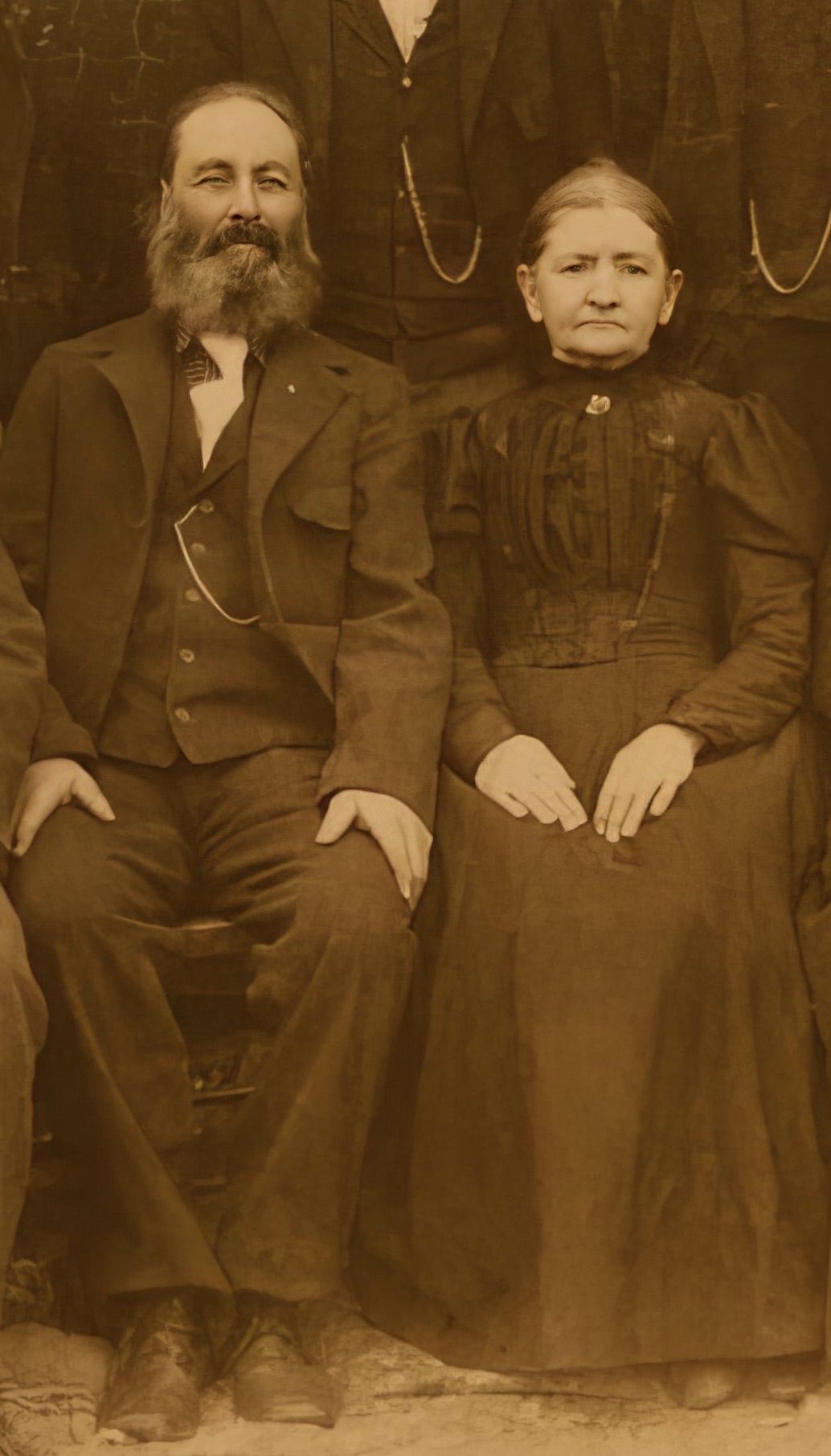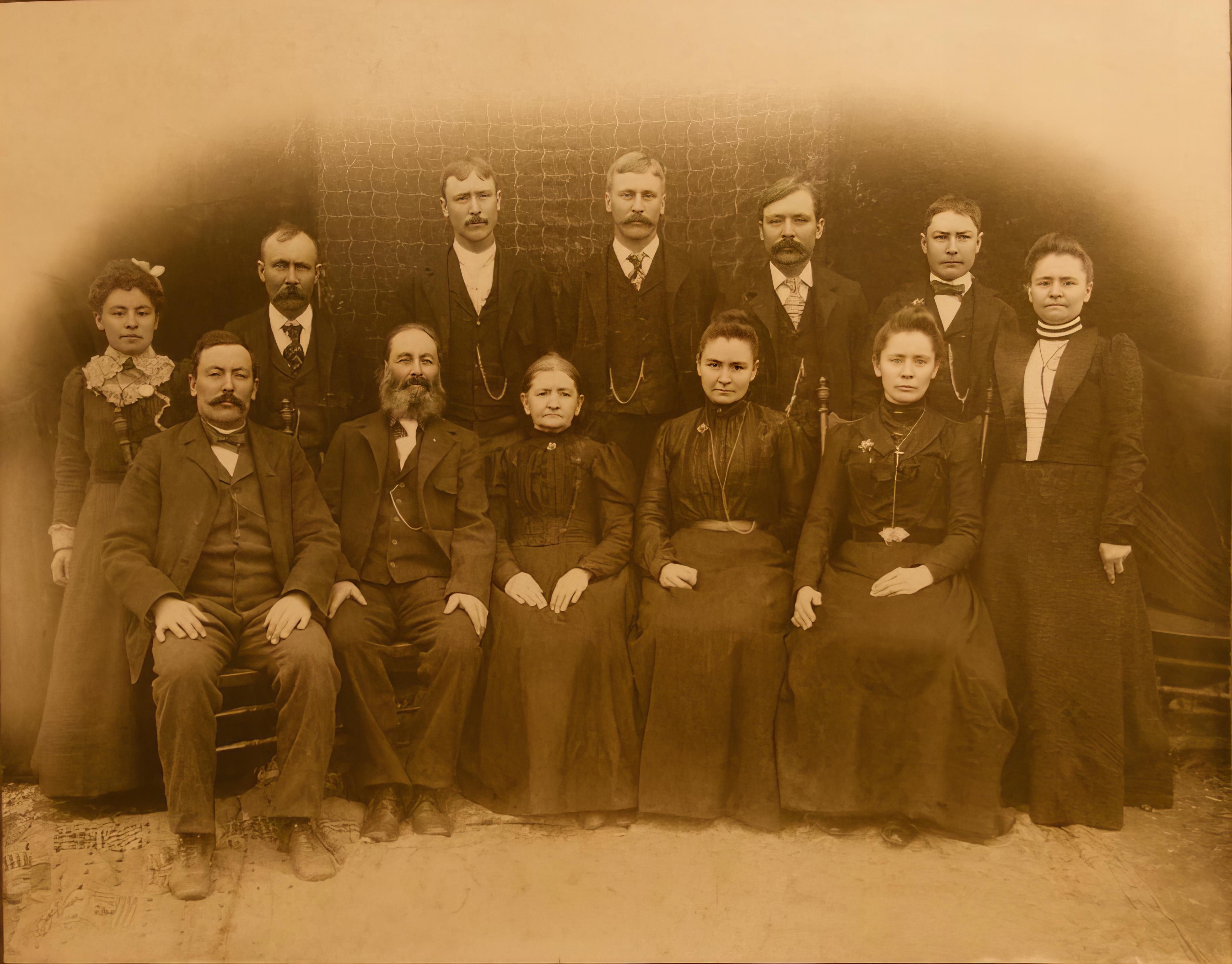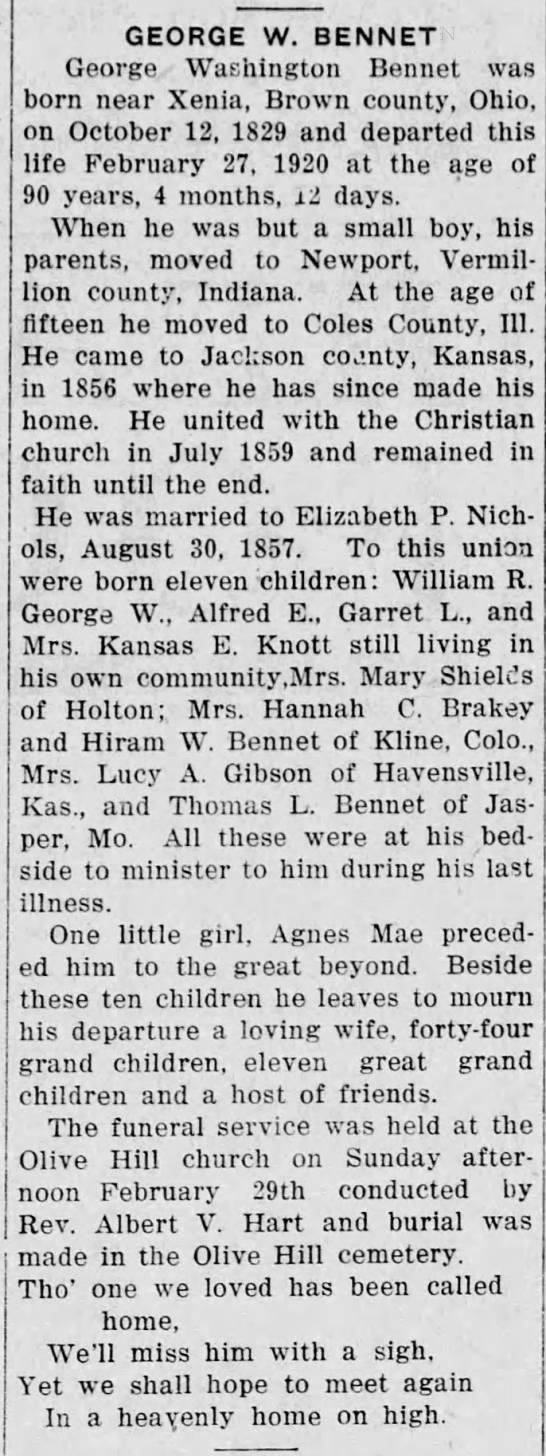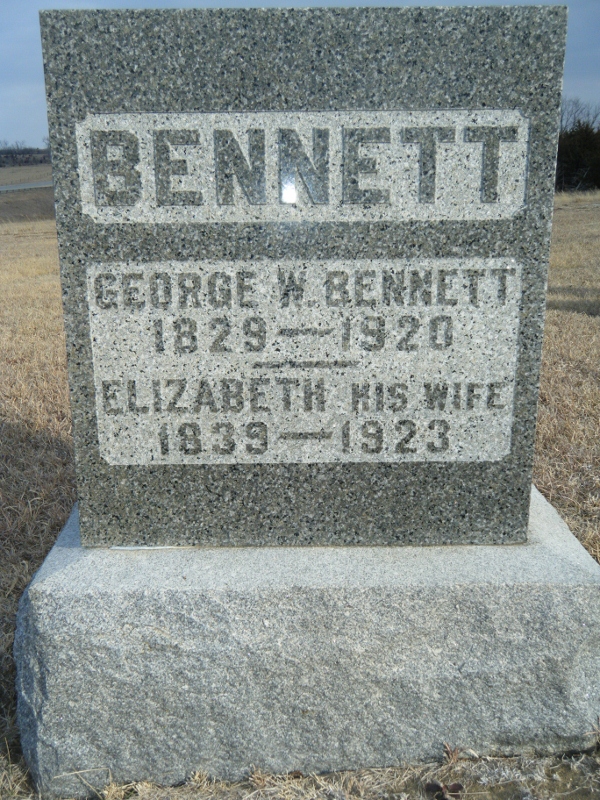George Washington Bennett I b. 12 OCT 1829 Brown Co., OH; d. 27 FEB 1920 Grant Twp., Jackson Co., KS; m. 30 AUG 1857 Leavenworth Co., KS; Elizabeth Pauline Nichols b. 13 JUL 1839 York Twp., Switzerland Co., IN; d. 11 FEB 1923 Grant Twp., Jackson Co., KS. Both buried: Olive Hill Cemetery, Jackson Co., KS.
CHILDREN:
1) William Ryston Bennett b. 1858
2) Mary Bennett b. 1860
3) Hannah Catherine Bennett b. 1863
4) Hiram Wakefield Bennett b. 1865
5) George Washington Bennett Jr. b. 1867
6) Lucy Amanda Bennett b. 1870
7) Kansas Elizabeth Bennett b. 1872
8) Alfred Emerson Bennett b. 1875
9) Thomas Leonard Bennett b. 1878
10) Agnes May Bennett b. 1881
11) Garrett Lovell Bennett b. 1884
PARENTS: Hannah Myers m. Hiram Bennett.
GEORGE WASHINGTON BENNETT was born October 12, 1829, near Xenia, in Greene County, Ohio. His parents were Hiram and Hannah (Myers) Bennett. Before he was a year old they moved to a farm near Newport, Vermillion County, Indiana, where his mother died in 1838. About two years later his father married Sarah Powell, and in 1845 the family, excepting the oldest son John, moved to a farm near Charleston, Coles County, Illinois. For the next nine years George lived part of the time in Coles
County and part of the time in Vermillion County.
In 1854 Kansas Territory was organized and opened to white settlers. The Government was offering good land at low prices in the new Territory, which attracted a heavy tide of immigrants from the higher priced land east of the Mississippi. George Bennett was then 25 years old, unmarried, employed as a farm hand in Coles County, Illinois, and he got what was called "Kansas fever." That year his uncle Jack Crane of Vermillion County, Indiana (husband of his mother's sister Sarah Myers) emigrated to Kansas Territory. Some years earlier his uncle Fred Cody (husband of his mother's sister Susanna Myers) had settled in Scott County, near Davenport, Iowa. His brother-in-law William Cruzan (husband of his sister Mary), living at near by Camargo, Illinois, also decided to "go West."
In the Fall of 1854 George Bennett and the Cruzans started on their long journey to Kansas in a covered wagon drawn by a team of oxen. They detoured by way of Scott County, Iowa, where they spent the winter with the Codys. In the early Spring they resumed their journey, in a larger covered wagon owned by Cody, drawn by Cruzan's oxen. From LeClaire, Iowa the moving party comprised nine people: Mr. and Mrs. Cruzan, Mr. and Mrs, Cody, George Bennett, Robert Page (George's cousin, son of Nancy Myers), William F. Cody (then in his early teens), and two small Cruzan children, Hiram and Sarah Jane. The covered wagon was heavily loaded with the Cruzan and Cody household effects, and roads were either nonexistent or very bad. The men walked most of the way, driving the oxen, pushing the wagon across streams and ditches and up hills, and sleeping on the ground at night. They arrived at Leavenworth in April, 1855.
The Cruzans moved in with their relatives, the Cranes, mentioned above, who had established a home near Leavenworth the previous summer. The Codys opened a boarding-house, where George Bennett, Bob Page, and Bill Cody lived, the three cousins having secured employment at the docks
and stables of overland freighting concerns at Leavenworth.
George Bennett and William Cruzan were looking for some good land in the newly organized Kansas Territory. Most of the land near the Missouri border had already been entered by early immigrants, and current land values had risen far beyond the original Government price of $1.25 per acre. At Cody's boarding-house, Bennett and Cruzan became acquainted with Jackson James, who was freighting a prairie schooner load of goods to his Trading Post in what is now Jackson County, Kansas. James urged them to look over the land in his region, which they did in the Fall of 1855. They "hitched" a ride with West-bound immigrants over the Oregon Trail to Soldier Creek, across the river from Topeka, and then on foot followed the creek in a northwesterly direction about 35 miles to
James' Trading Post.
Having selected a desirable location, in 1856 George Bennett went to the Lecompton Land Office and entered the land. It bordered on the north boundary of the Pottawatomie Indian Reservation, Soldier Creek flowing through it. There, in 1856, he built his cabin and became one of the early settlers of Jackson County. For about a year he was a "settler" in the sense of having a place of abode with a roof over his head. He had no live stock or farm equipment. He did not spend any more time than was necessary in his new home, because he had other "interests" demanding his
attention at Leavenworth. He had found "the girl" and wanted to get married before permanently settling down.
On August 30, 1857, at Leavenworth, Kansas Territory, GEORGE WASHINGTON BENNETT married ELIZABETH PAULINE NICHOLS, the ceremony being attended by his cousin William F. Cody, and her brother William F. Nichols.
Soon the newly-weds departed on their wedding journey for their new home. Loading all their movable earthly goods on a rude ox-cart, they "hit the Oregon Trail," which ran westward along the north side of the Kansas River. At Cross Creek, where George and Polly Bennett turned their ox-cart off the Trail one September day, they left behind them all signs of human habitation. For two days they meandered northward across the unbroken, rolling prairie toward their new home. There were no white
settlers along the way, none in Soldier Valley except Jackson James; no houses, no fences, no roads, not even a trail or a wagon track. A few miles to the east, and to the west, along Soldier and Cross Creeks, several hundred Delawres and Pottawatomies lived in wigwams and log huts, but the Indians did not occupy the prairies. The Cruzans arrived in Soldier Valley later that year.
The original Bennett cabin was located a few rods west of Soldier Creek. It evidently was built at that spot because of the accessibility of wood and water there. The timber grew along the Creek, and George had no facilities for transporting logs any great distance. He depended on the creek rather than a well for water. The site proved unsatisfactory because of the danger of high water.
After the original cabin had been flooded several times, he built another one farther from the creek. However, it was not entirely safe from floods. On September 4, 1880 he bought from Thomas J. McLin, for "50 cash and a stallion," 40 acres (valued at $250) adjoining his original quarter on the west, where there was already a log house, which became his third home in Soldier Valley.
Much of his original quarter was exceptionally fertile valley land; the rest of it was creek, timber, swamp and hill, not suitable for cultivation. From time to time he bought more land, both in his immediate vicinity and in an adjoining township. Some of this land was good farm land but much of it was suitable only for pasture and hay land. Part of it was tillable, but the soil was thin and stony. The fertility of this upland was not comparable with that of the valley.
George Bennett was never a "commercial farmer," in the sense of raising "cash crops" for market. There was no good market for grain in that area. He raised horses, hogs and cattle in such numbers as he could feed with his own grain and hay. He occasionally sold live stock to stock buyers, but most of it he butchered himself. He had a large and lucrative cured meat business with neighbors, especially the Indians.
He served briefly as a volunteer in the Union Army in 1863-4, mostly in training and guard duty, in the vicinity of Westport (now Kansas City), where he participated in one light skirmish. The War was then nearing its end, with no need for new recruits in the West. He was then past 34, had a wife and three small children, with nobody to plant his crop; so he was mustered out and returned home early in 1864.
George Bennett was never an outstanding leader in his community. He took little or no interest in politics, certainly not enough to participate in political activities. He was merely a substantial farmer and citizen who gave little attention to public affairs. He served on the local School Board for many years.
He had no school education at all. He could neither read nor write; though illiterate, he was by no means ignorant. He was a man of natural intelligence, quick in picking up information of all kinds. He had sound common sense and good business judgment. He had his eccentricities: such as lack of confidence in banks and paper currency. He had experienced the panics of 1837 and 1857, and the Greenback era following the Civil War. His policy was to do business on a "cash or trade" basis, and to him "cash" was gold or silver coin. He kept his surplus funds well hidden. He did not hoard money, but invested it in live stock and real estate as sufficient amounts accumulated. He indulged in very few luxuries. He planted his crops and butchered his hogs according to the moon's phases as set forth in Dr. Wakefield's Almanac; and he got results at least no worse than did those who ignored the moon.
He was not an active churchman. He joined the Christian (the so called Campbellite) Church in July, 1859, and remained a member of that denomination through the rest of his life. Religiously, he was an "ultra" fundamentalist. He firmly believed that, according to the Bible, the earth is "flat, with four corners"--though he owned several hundred acres of it that seemed to contradict his "flat" belief.
George Bennett was a "rugged individualist." He did not oppose community organizations, but merely ignored them. Unlike most of his neighbors, he did not make it a practice to go to town Saturday afternoons to meet people; his occasional trips to Soldier, Circleville, and Holton were strictly business errands. He usually spent his Sundays at home. However, he was not at all an unsociable recluse; he welcomed visitors at his home and was a cordial host, but temperamentally he was not a
"joiner and mixer." He would sometimes, but not frequently, attend a Fourth-of-July celebration, a Sunday School picnic, or a camp-meeting, if he found it convenient to do so, and in his earlier years he often would take the family to a circus. He once expressed his social attitude: "I 'tend to my own business and let other people 'tend to theirs."
Like most pioneers, he had an instinctive aversion to strangers--especially, he was suspicious of well-dressed, smooth-mannered, glib talkers who had something to sell. About the only "agents" who could pierce his armor were the medicine vendors; he had a weakness for "patent medicine", especially if he could pay for it with a meal or a night's lodging. He was a good "trader"; not in the sense of being "sharp," but because he was deliberate, and often obstinate; it was difficult to "talk him into" doing anything about which he had his doubts.
He was not a "reactionary" in any sense of the word, nor was he an active "progressive." He was a "conservative"--very conservative. He did not move backward, and he did not stand still; he progressed forward with extreme deliberation. His advance was retarded by his caution. He did not act on intuition or impulse; he had no gambling instinct whatever, and took very few risks that he could avoid. His progress was substantial in the long run, but it probably would have been much more rapid if he had not been so reluctant about taking reasonable chances now and then.
Years after fence wire was in general use, his farmyard was cluttered with rail and stone fences. Long after his neighbors had built fine barns and outbuildings, he continued to use rail corn cribs, and pole stables and stock sheds covered with brush and straw. He was among the last to move out of a log cabin. As long as he had old material and obsolete farm equipment around, he was inclined to make it do, use it up, wear it out, rather than invest in something more modern. His pattern of life was fairly well moulded and set before the Civil War, and he was slow to change it. He grew up during a period when time was plentiful and labor was cheap and abundant; so time-saving and labor-saving did not appeal to him strongly. Consequently, he was never the first to experiment with something new, and he was usually the last to discard something old that had served him well in the past. His character may be summed up in one word--"conservative." He faced forward, but he kept his feet firmly anchored on solid ground--and he seldom leaped in the dark.
About 1900 he bought a frame house from George Christy and moved it to the yard of the log cabin where he had lived many years, and moved into it. A few years later he bought the Ackerson place, an adjoining farm in the valley, which had a better house and outbuildings, so he moved up the
road about a quarter of a mile. There he spent the rest of his life.
GEORGE WASHINGTON BENNETT died February 27, 1920, aged 90 years, having lived for 64 years within a quarter-mile of where he built his pioneer cabin on the banks of Soldier Creek. He was buried in the Olive Hill Cemetery, about three miles north of his home farm.
From "The Bennett Book," by John A. Shields, privately published April 16, 1956, reprinted in September, 2021.
George Washington Bennett I b. 12 OCT 1829 Brown Co., OH; d. 27 FEB 1920 Grant Twp., Jackson Co., KS; m. 30 AUG 1857 Leavenworth Co., KS; Elizabeth Pauline Nichols b. 13 JUL 1839 York Twp., Switzerland Co., IN; d. 11 FEB 1923 Grant Twp., Jackson Co., KS. Both buried: Olive Hill Cemetery, Jackson Co., KS.
CHILDREN:
1) William Ryston Bennett b. 1858
2) Mary Bennett b. 1860
3) Hannah Catherine Bennett b. 1863
4) Hiram Wakefield Bennett b. 1865
5) George Washington Bennett Jr. b. 1867
6) Lucy Amanda Bennett b. 1870
7) Kansas Elizabeth Bennett b. 1872
8) Alfred Emerson Bennett b. 1875
9) Thomas Leonard Bennett b. 1878
10) Agnes May Bennett b. 1881
11) Garrett Lovell Bennett b. 1884
PARENTS: Hannah Myers m. Hiram Bennett.
GEORGE WASHINGTON BENNETT was born October 12, 1829, near Xenia, in Greene County, Ohio. His parents were Hiram and Hannah (Myers) Bennett. Before he was a year old they moved to a farm near Newport, Vermillion County, Indiana, where his mother died in 1838. About two years later his father married Sarah Powell, and in 1845 the family, excepting the oldest son John, moved to a farm near Charleston, Coles County, Illinois. For the next nine years George lived part of the time in Coles
County and part of the time in Vermillion County.
In 1854 Kansas Territory was organized and opened to white settlers. The Government was offering good land at low prices in the new Territory, which attracted a heavy tide of immigrants from the higher priced land east of the Mississippi. George Bennett was then 25 years old, unmarried, employed as a farm hand in Coles County, Illinois, and he got what was called "Kansas fever." That year his uncle Jack Crane of Vermillion County, Indiana (husband of his mother's sister Sarah Myers) emigrated to Kansas Territory. Some years earlier his uncle Fred Cody (husband of his mother's sister Susanna Myers) had settled in Scott County, near Davenport, Iowa. His brother-in-law William Cruzan (husband of his sister Mary), living at near by Camargo, Illinois, also decided to "go West."
In the Fall of 1854 George Bennett and the Cruzans started on their long journey to Kansas in a covered wagon drawn by a team of oxen. They detoured by way of Scott County, Iowa, where they spent the winter with the Codys. In the early Spring they resumed their journey, in a larger covered wagon owned by Cody, drawn by Cruzan's oxen. From LeClaire, Iowa the moving party comprised nine people: Mr. and Mrs. Cruzan, Mr. and Mrs, Cody, George Bennett, Robert Page (George's cousin, son of Nancy Myers), William F. Cody (then in his early teens), and two small Cruzan children, Hiram and Sarah Jane. The covered wagon was heavily loaded with the Cruzan and Cody household effects, and roads were either nonexistent or very bad. The men walked most of the way, driving the oxen, pushing the wagon across streams and ditches and up hills, and sleeping on the ground at night. They arrived at Leavenworth in April, 1855.
The Cruzans moved in with their relatives, the Cranes, mentioned above, who had established a home near Leavenworth the previous summer. The Codys opened a boarding-house, where George Bennett, Bob Page, and Bill Cody lived, the three cousins having secured employment at the docks
and stables of overland freighting concerns at Leavenworth.
George Bennett and William Cruzan were looking for some good land in the newly organized Kansas Territory. Most of the land near the Missouri border had already been entered by early immigrants, and current land values had risen far beyond the original Government price of $1.25 per acre. At Cody's boarding-house, Bennett and Cruzan became acquainted with Jackson James, who was freighting a prairie schooner load of goods to his Trading Post in what is now Jackson County, Kansas. James urged them to look over the land in his region, which they did in the Fall of 1855. They "hitched" a ride with West-bound immigrants over the Oregon Trail to Soldier Creek, across the river from Topeka, and then on foot followed the creek in a northwesterly direction about 35 miles to
James' Trading Post.
Having selected a desirable location, in 1856 George Bennett went to the Lecompton Land Office and entered the land. It bordered on the north boundary of the Pottawatomie Indian Reservation, Soldier Creek flowing through it. There, in 1856, he built his cabin and became one of the early settlers of Jackson County. For about a year he was a "settler" in the sense of having a place of abode with a roof over his head. He had no live stock or farm equipment. He did not spend any more time than was necessary in his new home, because he had other "interests" demanding his
attention at Leavenworth. He had found "the girl" and wanted to get married before permanently settling down.
On August 30, 1857, at Leavenworth, Kansas Territory, GEORGE WASHINGTON BENNETT married ELIZABETH PAULINE NICHOLS, the ceremony being attended by his cousin William F. Cody, and her brother William F. Nichols.
Soon the newly-weds departed on their wedding journey for their new home. Loading all their movable earthly goods on a rude ox-cart, they "hit the Oregon Trail," which ran westward along the north side of the Kansas River. At Cross Creek, where George and Polly Bennett turned their ox-cart off the Trail one September day, they left behind them all signs of human habitation. For two days they meandered northward across the unbroken, rolling prairie toward their new home. There were no white
settlers along the way, none in Soldier Valley except Jackson James; no houses, no fences, no roads, not even a trail or a wagon track. A few miles to the east, and to the west, along Soldier and Cross Creeks, several hundred Delawres and Pottawatomies lived in wigwams and log huts, but the Indians did not occupy the prairies. The Cruzans arrived in Soldier Valley later that year.
The original Bennett cabin was located a few rods west of Soldier Creek. It evidently was built at that spot because of the accessibility of wood and water there. The timber grew along the Creek, and George had no facilities for transporting logs any great distance. He depended on the creek rather than a well for water. The site proved unsatisfactory because of the danger of high water.
After the original cabin had been flooded several times, he built another one farther from the creek. However, it was not entirely safe from floods. On September 4, 1880 he bought from Thomas J. McLin, for "50 cash and a stallion," 40 acres (valued at $250) adjoining his original quarter on the west, where there was already a log house, which became his third home in Soldier Valley.
Much of his original quarter was exceptionally fertile valley land; the rest of it was creek, timber, swamp and hill, not suitable for cultivation. From time to time he bought more land, both in his immediate vicinity and in an adjoining township. Some of this land was good farm land but much of it was suitable only for pasture and hay land. Part of it was tillable, but the soil was thin and stony. The fertility of this upland was not comparable with that of the valley.
George Bennett was never a "commercial farmer," in the sense of raising "cash crops" for market. There was no good market for grain in that area. He raised horses, hogs and cattle in such numbers as he could feed with his own grain and hay. He occasionally sold live stock to stock buyers, but most of it he butchered himself. He had a large and lucrative cured meat business with neighbors, especially the Indians.
He served briefly as a volunteer in the Union Army in 1863-4, mostly in training and guard duty, in the vicinity of Westport (now Kansas City), where he participated in one light skirmish. The War was then nearing its end, with no need for new recruits in the West. He was then past 34, had a wife and three small children, with nobody to plant his crop; so he was mustered out and returned home early in 1864.
George Bennett was never an outstanding leader in his community. He took little or no interest in politics, certainly not enough to participate in political activities. He was merely a substantial farmer and citizen who gave little attention to public affairs. He served on the local School Board for many years.
He had no school education at all. He could neither read nor write; though illiterate, he was by no means ignorant. He was a man of natural intelligence, quick in picking up information of all kinds. He had sound common sense and good business judgment. He had his eccentricities: such as lack of confidence in banks and paper currency. He had experienced the panics of 1837 and 1857, and the Greenback era following the Civil War. His policy was to do business on a "cash or trade" basis, and to him "cash" was gold or silver coin. He kept his surplus funds well hidden. He did not hoard money, but invested it in live stock and real estate as sufficient amounts accumulated. He indulged in very few luxuries. He planted his crops and butchered his hogs according to the moon's phases as set forth in Dr. Wakefield's Almanac; and he got results at least no worse than did those who ignored the moon.
He was not an active churchman. He joined the Christian (the so called Campbellite) Church in July, 1859, and remained a member of that denomination through the rest of his life. Religiously, he was an "ultra" fundamentalist. He firmly believed that, according to the Bible, the earth is "flat, with four corners"--though he owned several hundred acres of it that seemed to contradict his "flat" belief.
George Bennett was a "rugged individualist." He did not oppose community organizations, but merely ignored them. Unlike most of his neighbors, he did not make it a practice to go to town Saturday afternoons to meet people; his occasional trips to Soldier, Circleville, and Holton were strictly business errands. He usually spent his Sundays at home. However, he was not at all an unsociable recluse; he welcomed visitors at his home and was a cordial host, but temperamentally he was not a
"joiner and mixer." He would sometimes, but not frequently, attend a Fourth-of-July celebration, a Sunday School picnic, or a camp-meeting, if he found it convenient to do so, and in his earlier years he often would take the family to a circus. He once expressed his social attitude: "I 'tend to my own business and let other people 'tend to theirs."
Like most pioneers, he had an instinctive aversion to strangers--especially, he was suspicious of well-dressed, smooth-mannered, glib talkers who had something to sell. About the only "agents" who could pierce his armor were the medicine vendors; he had a weakness for "patent medicine", especially if he could pay for it with a meal or a night's lodging. He was a good "trader"; not in the sense of being "sharp," but because he was deliberate, and often obstinate; it was difficult to "talk him into" doing anything about which he had his doubts.
He was not a "reactionary" in any sense of the word, nor was he an active "progressive." He was a "conservative"--very conservative. He did not move backward, and he did not stand still; he progressed forward with extreme deliberation. His advance was retarded by his caution. He did not act on intuition or impulse; he had no gambling instinct whatever, and took very few risks that he could avoid. His progress was substantial in the long run, but it probably would have been much more rapid if he had not been so reluctant about taking reasonable chances now and then.
Years after fence wire was in general use, his farmyard was cluttered with rail and stone fences. Long after his neighbors had built fine barns and outbuildings, he continued to use rail corn cribs, and pole stables and stock sheds covered with brush and straw. He was among the last to move out of a log cabin. As long as he had old material and obsolete farm equipment around, he was inclined to make it do, use it up, wear it out, rather than invest in something more modern. His pattern of life was fairly well moulded and set before the Civil War, and he was slow to change it. He grew up during a period when time was plentiful and labor was cheap and abundant; so time-saving and labor-saving did not appeal to him strongly. Consequently, he was never the first to experiment with something new, and he was usually the last to discard something old that had served him well in the past. His character may be summed up in one word--"conservative." He faced forward, but he kept his feet firmly anchored on solid ground--and he seldom leaped in the dark.
About 1900 he bought a frame house from George Christy and moved it to the yard of the log cabin where he had lived many years, and moved into it. A few years later he bought the Ackerson place, an adjoining farm in the valley, which had a better house and outbuildings, so he moved up the
road about a quarter of a mile. There he spent the rest of his life.
GEORGE WASHINGTON BENNETT died February 27, 1920, aged 90 years, having lived for 64 years within a quarter-mile of where he built his pioneer cabin on the banks of Soldier Creek. He was buried in the Olive Hill Cemetery, about three miles north of his home farm.
From "The Bennett Book," by John A. Shields, privately published April 16, 1956, reprinted in September, 2021.
Family Members
-
![]()
William Ryston "Dock" Bennett
1858–1951
-
![]()
Mary Bennett Shields
1860–1927
-
![]()
Hannah Catherine "Kate" Bennett Brakey
1863–1937
-
![]()
Hiram Wakefield "Johnny Jack" Bennett
1865–1957
-
![]()
George Washington Bennett Jr
1868–1938
-
![]()
Lucy Amanda Bennett Gibson
1870–1928
-
![]()
Kansas Elizabeth Bennett Nott
1872–1953
-
![]()
Alfred Emerson Bennett
1875–1973
-
![]()
Thomas Leonard Bennett
1878–1941
-
![]()
Agnes May "Dollie" Bennett
1881–1889
-
![]()
Garrett Lovell Bennett
1884–1976
Sponsored by Ancestry
Advertisement
Explore more
Sponsored by Ancestry
Advertisement
